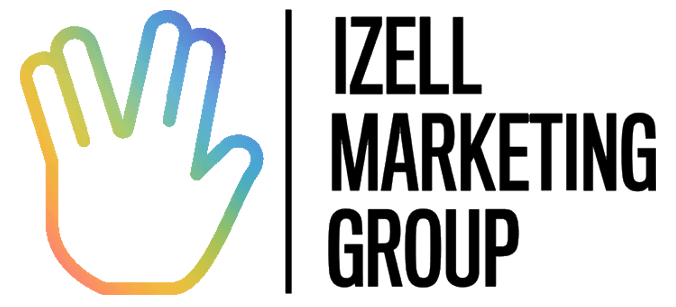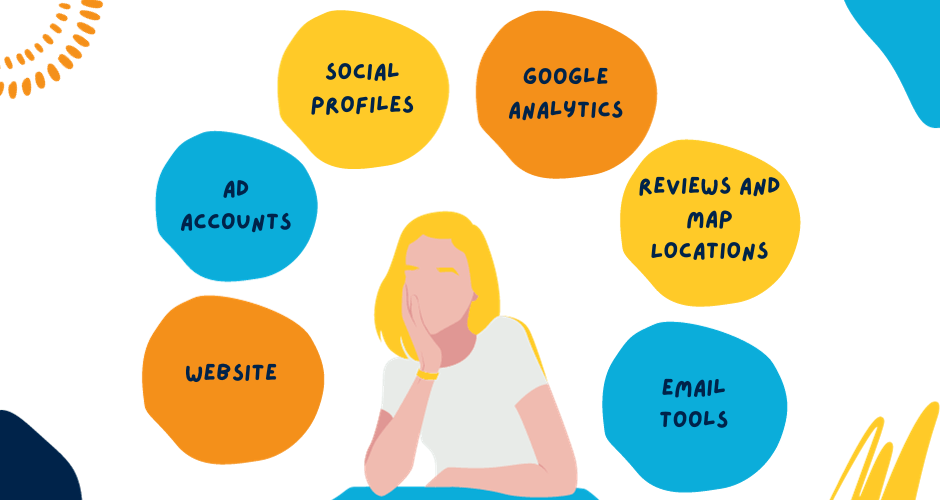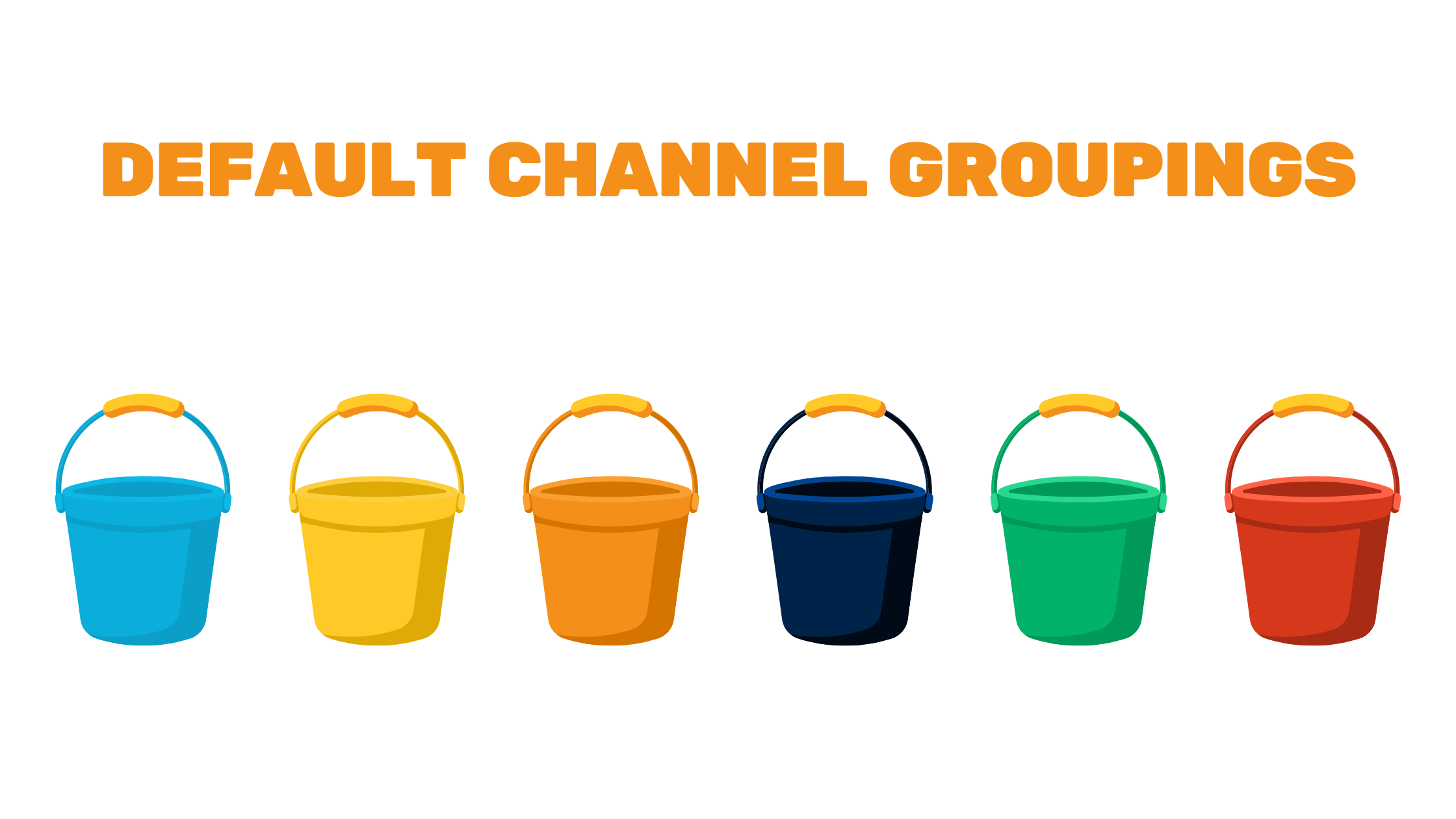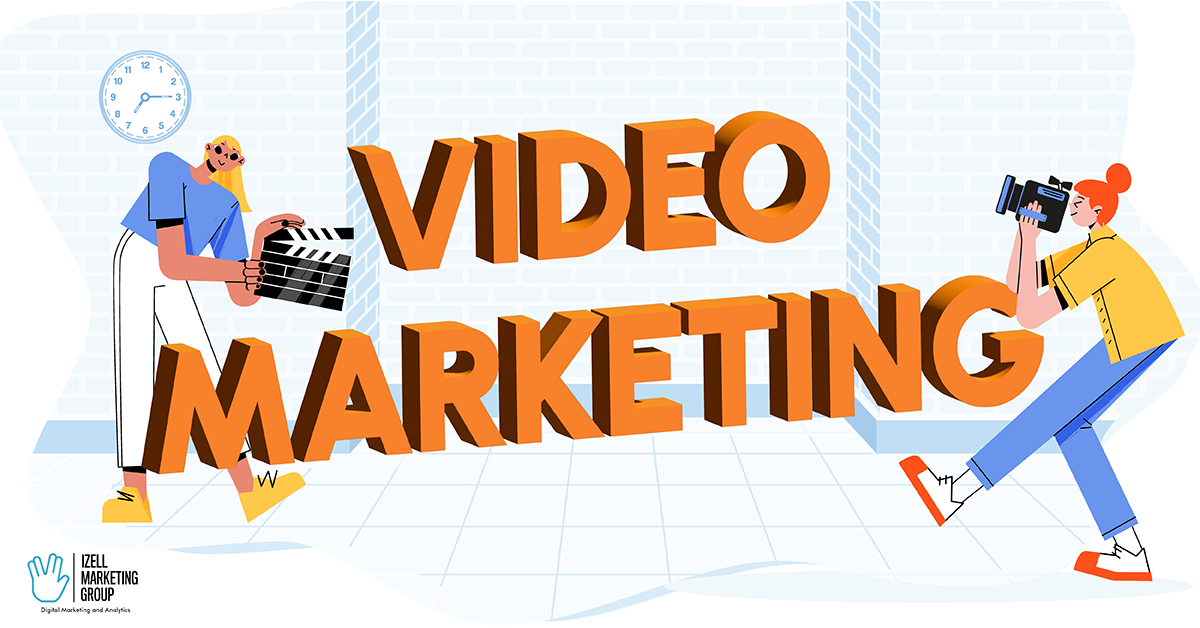Your marketing assets and online presence are crucial to business success, and they are also the source of all the data that will inform you about your performance in the digital space. Agencies who don’t set up your accounts correctly or who refuse to give you ownership or admin access are a major red flag!
This could indicate that they don’t understand best practices of data and account ownership, or even indicate malicious intent like attempting to hide the true performance of their work or make it harder for you to switch agencies. We absolutely insist on transparency and your right to choose the best agency for your business, and we want to be your partner on this journey.
Your accounts and other assets are very valuable to your business, and that value only grows as you collect data and gain brand recognition. It can be devastating to find out that your accounts and assets are actually owned by a former marketing partner. Whether or not they have good intentions and are willing to transfer the ownership correctly, it can be time consuming to correct it.
While it’s not the end of the world to start over if they can’t or won’t cooperate, it can negatively impact the business in terms of lost performance data with valuable insights, and loss of brand recognition for the website and social profiles, and of course, be costly in time to recreate the assets.
Here are our best practices to ensure your business properly owns the most commonly used digital marketing assets:
You should own the domain of your company’s website, whether you’ve purchased it through GoDaddy, Namecheap, or from somewhere else. Your website address is one of the most important pieces of your online presence, and if you don’t own it, you are at risk of your website going down, as well as at risk of losing your ability to use your familiar website address.
Domains have to be renewed periodically (typically annually). To ensure you have no gaps in your website’s usability, you’ll want to make sure you own the domain in your own account. Make note of what email address is used to sign in, and make sure other internal users know how to access it. Make sure to protect the password to this account, and change it as needed after employee/partner turnover to protect your site.
If you have worked with a website developer who owns your domain, work with them to transfer it into your own account, and put the domain on auto-renewal. Most domain registrars have options to grant access to additional accounts or specify a technical contact, which will allow the developer to continue working on your site as needed.
Make sure any future developers and marketing partners are willing and knowledgeable enough to ensure proper ownership of the domain, or else we think that’s a 
Worst case: If your domain is lost due to an malicious or inexperienced marketing partner, you will have to purchase a different domain. You will not be able to control the content posted on your previous domain, and you’ll have to do a full audit of all your materials, both internal and client facing, to ensure you only list your new website.
Typically, it’s best for a business to own and manage its own hosting and to add their developers and marketing partners as additional accounts with access. Hosting plans have periodic billing, typically monthly or annually, and this ensures no gaps in your website’s usability. Examples of what you might be using as your hosting is an actual hosting platform like WPEngine, or a CMS like Shopify, Wix, WebFlow, or SquareSpace.
If your developer has sole ownership of your website’s hosting, work with them to transfer it into your own account and ensure that you are on auto-pay. Grant your developer access to manage your website through the options your hosting provider offers. Create internal documentation about how to manage hosting, and periodically review and update the people who have access to make necessary changes due to employee turnover and/or when changing developers.
While it’s not necessarily a 
Worst case: If you lose access to your web hosting due to a malicious or inexperienced marketing partner or due to employee turnover, you will need to rebuild your website on a new hosting plan and point your domain to the new hosting in your domain manager’s DNS records.
Depending on the complexity of your website, this could take a lot of time to rebuild, but you would not have to purchase a new website address (domain) and make all the changes associated with that.
Your Google Ads account can contain a wealth of historical data that can be used to further optimize your ads for best results. The best way to give access to an agency is for them to request to manage it through their “Manager Account.”
Agencies should be using a manager account, which is hierarchically a level higher than your ad account and can contain access for multiple employees to access multiple client accounts. All you have to do is tell your agency your account number, and they will send a request that, once approved, will allow them to fully manage your account.
Your own internal employees should be added as admin users on the account, and it’s important to make sure you have added a few in case of any turnover.
Granting access in this way ensures that your company can continue to access your Google Ads account, and build on the historical data and the strategy story that data tells, even if you change marketing partners. You would simply remove the link to the old marketing partner’s manager account, and accept the linking invitation to a new marketing partner’s manager account.
What if your new marketing partner doesn’t have an agency account and insists on getting access in a different way, either by asking to be added as an admin user or worse, asking for your Google password?
We think that’s a 
Another 
We also typically don’t set up a client’s Google Ads account, because this can cause some complicated issues later with “payment profiles” and other billing setups. While it is possible to correct these issues, we know that the decision to change marketing partners is not an easy one to make and we always want to make sure that this process is as easy as possible. If that’s your decision, you won’t want to waste any time taking steps that we can simply avoid with a proper initial setup.
Additionally, requiring our clients to set up their Google Ads account while we guide them on a video chat ensures that someone internally knows how to access the account, reducing the risk of the client losing access in the future due to unfamiliarity or confusion.
Worst case: If you can no longer access your Google Ads account due to turnover in your marketing partners or internally, it is no problem to set up a new account. This may take a few minutes, but we will make sure everything is configured properly, including access, billing, account structure, and conversion tracking. You will lose access to any historical performance data. Also, there is some risk in having an account lingering with an active payment method. You may want to cancel the card on that account and ensure your accounts are set up correctly by a reputable agency going forward.
Managing assets within the complicated ecosystem of Meta is by far the most complex part of getting access with our new clients.
Meta Business Manager is a level of account organization that contains your Facebook and Instagram assets. You also should be managing access to these assets within Business Manager, as opposed to on the asset level.
Here’s an example of how our Business Manager is structured:
We have one Business Manager Account for Izell Marketing Group. This account contains
- 1 Facebook Page (Izell Marketing Group)
- 1 Instagram Profile (@izellmarketing)
- 1 Meta Ads Account for Izell Marketing Group’s own digital marketing on Facebook and Instagram
- 1 Meta Pixel used for tracking after an ad click from our Meta Ads account
- many Partner connections with the Business Manager accounts of our clients. This gives us the access to run ads on their behalf without us taking ownership of their assets.
Izell Marketing Group employees are added as admins on the Business Manager account level, giving each employee access to all assets within the Manager, including the assets our clients grant us access to.
You may or may not have already structured your business assets under Meta’s Business Manager. We find that many clients have already done this and aren’t aware. We ask new clients to visit https://business.facebook.com/select and see if any Business Manager accounts are listed there. Then we check to see if the assets we need are already in the account, or if they need to be moved under that Business Manager umbrella or created within it. If a client needs help, we’ll have them add one of us as an admin in their Business Manager to finish the setup and create the partner connection to Izell Marketing’s Business Manager.
In rare situations, these accounts were created and still owned by former marketing partners and former employees, so we have to coach our new clients in what to ask for to transfer the ownership.
Done correctly, this will set our clients up for success with us and with any future marketing partners. We make sure our clients understand that they need to add a few trusted internal employees as admins on their Business Manager account, and review access regularly to remove and add employees due to turnover. We provide detailed notes on how to login to Meta Business Manager and who has access.
Worst Case
You can almost certainly track down who has access to your Meta Assets with a bit of reflection on who might have set them up. It’s then just a matter of guiding them through adding a current admin, who can remove them, and documenting how to access this in the future without any trouble. Typically, most problems during this process are due to the confusing nature of the platform and the complicated interface. We are always available to help our clients figure out where to click and what steps to take.
The most important assets in this scenario are your Facebook Page and Instagram account, because you’ve worked hard to build your following. Starting over with these assets will mean that you have to rebuild your following and credibility, and also that there will be a “zombie” profile living out there without fresh content. That can be confusing for potential and current clients/customers.
Not to worry though! We have always been successful in recovering access to these assets with every single one of our clients -even if it means we have to get on the phone with Meta support. All we require is our clients’ commitment to remembering who may have been involved in the creation of these assets and their cooperation in walking through the interface on a screenshare if needed. In our worst case scenario, we have also needed our clients to cooperate in providing business documentation to Meta support to get their assistance.
All other assets – pixels, ad account, catalog, etc – contain valuable historical data and can be time consuming to recreate, but it is definitely not the end of the world to recreate them. If we have to do this, we will make sure you understand how to access them going forward so you will never have to recreate them again.
For old ad accounts, there is some risk in having an account lingering with an active payment method. You may want to cancel the card on that account and ensure your accounts are set up correctly by a reputable agency going forward.
If your business is active on LinkedIn, you probably already have a Company Page. To run ads, you will also need an ad account. You should have several internal employees added as Super Admins. There are additional access levels with reduced permissions, but only Super Admins are able to add additional users and admins, so keep this current through any turnover.
We ask our clients to add one of our agency team as a Super Admin, and that person is then able to add the rest of our team assigned to the account as admins. Page access is required to run LinkedIn ads that use the LinkedIn Company Page.
Admin access to your LinkedIn ad account should also be granted to several internal employees and updated regularly to stay current through any turnover. Each ad account can have only one Billing Admin, and that person is the only user who can edit the payment method. This access can be reassigned, but once reassigned, the payment method will have to be updated.
We ask our clients to add one of our agency team as an Account Manager, and that person is then able to add the rest of the assigned team to the ad account.
This is how we handle most of our client access on LinkedIn, because most clients have only one Company Page and one ad account, but for more complex setups (multiple brands with multiple Company Pages, multiple ad accounts, etc), LinkedIn recommends using LinkedIn Business Manager. Similar to Meta Business Manager, this setup allows companies to manage access across multiple assets more easily and to partner with an agency’s Business Manager. In general, if you have your assets structured like this, we’ll get access via a partner connection, and otherwise, we’ll get access on the page and ad account level.
Worst Case
The most important asset is your LinkedIn Company Page. This would be time consuming to recreate because your business has already worked hard to build out the page, get followers, and it is also connected to your employees who have built out their profiles. It’s important to take the steps to recover access to the page if necessary, including thinking back to who created the page initially, or getting support from LinkedIn. Once you’ve recovered access, make sure to add several internal employees as admins and evaluate access regularly going forward.
For the LinkedIn ad account, it would be a loss of any historical data if you can’t recover access, but it would not be as serious as losing the Company Page. You might want to cancel the credit card associated with the old account if you can’t recover access. Whether you recover access or create a new ad account, make sure to share access to a few internal employees and evaluate access regularly going forward.
Microsoft Ads (formerly known as Bing Ads) is another asset that we cannot create for you, since it isn’t possible to transfer ownership of an ad account created within our agency manager account. Similar to Google Ads, we will guide you through creating the account. Then, using the account ID, we will request access to manage the account. That will give us the ability to run ads on your behalf without you losing ownership.
Like all assets, we recommend ensuring that plenty of trusted internal users have access to this account and know how to log in. This does require that the user first create a free Microsoft account (we recommend using a work email address). Only then you can make them an admin on the account.
Periodically review access to the account, removing any Manager accounts and users who no longer need access, and add any new employees to ensure you don’t lose access due to turnover.
Worst case: Most of our clients don’t have significant history in their Microsoft Ad accounts, so it’s not a great loss to have to create a new one. We still prefer to get you set up for success with us; it is our goal to ensure that you have the ability to continue using the same account going forward for the best results in optimization.
There is some risk in having an account lingering with an active payment method. You may want to cancel the card on that account and ensure your accounts are set up correctly by a reputable agency going forward.
Google Analytics is an asset we can create for you if needed. To properly configure all necessary settings, we need admin access on the account level, not the property level.
A common scenario with our new clients is a former marketing partner who has structured multiple client Google Analytics properties within the same Google Analytics account. Since that is not recommended by Google, we work with those former partners to transfer the property into its own account. Ensure that the client is an admin on the account level and that we are also account level admins for the duration of our work with the client.
To use many Google marketing products, including Google Analytics, you’ll need to have a Google account. This includes all gmail accounts, work emails that are hosted through Google Workspaces, and Google Accounts created with a work email address. If you have one of those, you can be an admin of your own Google Assets, and we’ll make sure you are.
Worst case: If you don’t know who created your Google Analytics account and property and can’t recover access, you’ll lose your historical data of how users used your website, such as top pages, where the traffic came from, form submissions, purchases, and average session durations. We like to have this historical data for benchmarking, but the next best alternative is to get you properly set up ASAP and make sure you don’t lose access again in the future.
Google Tag Manager is another Google product that we can create for you then make you an admin. You will have to accept the invitation, which is a commonly missed step. But if you already have GTM installed on your website, we’ll want to attempt to recover access to the existing account and all the custom configuration it contains, plus add any additional tracking necessary.
Worst case: If you can’t recover access to the existing container, we can use tools to identify the configuration it contains and recreate the existing configuration, plus add any additional tracking as needed. This is a common issue that we face with new clients/ Google will not assist in account recovery, so once we have an account recovered or recreated, we ask our clients to add a few trusted internal users and to document how to access the tool so they never have to make a new one again.
Your Google My Business is the place to manage your Google Map listings and your Google Reviews, so it’s an extremely important piece of your digital strategy.
You’ll want to ensure that your company remains the “Primary Owner” of your Google My Business location. This has to be with a Google account, so any gmail, or work email that is set up in Google Workspaces, or any Google account created with your work email will work here. Make sure that this account will remain within the business and you don’t lose the password due to employee turnover. If necessary, a primary owner can transfer primary ownership to a different account.
Beyond that, you can add additional “owners” and “managers” as needed to manage the profile. You may want to add your marketing partners as managers rather than owners; that prevents them from removing other users and from removing the business listing.
However, a trustworthy and reputable marketing partner can be added as an owner if you feel comfortable – there can be multiple users with the “owner” status. You can always begin by adding a marketing partner as a manager, and then increase permissions to owner if needed.
Worst case: Since your Google Reviews are so important to your business, if you are unable to locate who has ownership of your listings or if an unscrupulous former employee or marketing partner will not cooperate, you will want to contact Google for assistance. In many cases, they will assist you in recovering access if you can prove ownership of or the responsibility to manage the business.
Every email platform has a different set of instructions for granting access, whether it’s MailChimp or ActiveCampaign or Klaviyo. We will advise based on the specific platforms, and whenever possible, we want to be able to use our own login so you won’t have to share your password with us.
Many platforms allow you to add agencies without paying for an additional user, or they allow additional users without additional fees.
In the rare situation where that’s not the case, we will ask you to share your login in a secure way (our favorite way is LastPass) and we will store that password in LastPass to ensure it’s secure.
Our recommendation would be that you change the password when changing marketing partners.
Worst case: If you lose access to your email marketing platform, you’ll lose your previous performance data, like open and click rates, as well as your previous email designs. We’d recommend taking a deep breath, and then then taking a serious look at what the different platforms have to offer, and how much each plan costs. Starting fresh is not the end of the world, and it could be an opportunity to find a platform that better suits your needs.
We aren’t perfect; we’ve made some mistakes as we’ve learned about the best practices for each platform, but a good agency is going to have your best interests in mind. This means taking the time to set up the accounts in a way that preserves your ownership and full access, correcting any access errors made along the way, and also provide assistance in recovering existing accounts whenever possible so you can build on your existing data.
We want our clients to love working with us and partner with us for the long-term, but we also want them to be successful with any marketing partners in the future. That means helping you build and grow with your existing accounts rather than forcing you to start over!
If you’ve been struggling with creating new accounts or getting access, we’d love to work with you and help you get set up for success. If you’re not even sure where to start, we can help find the best digital marketing strategies that will fit your goals and budget.




